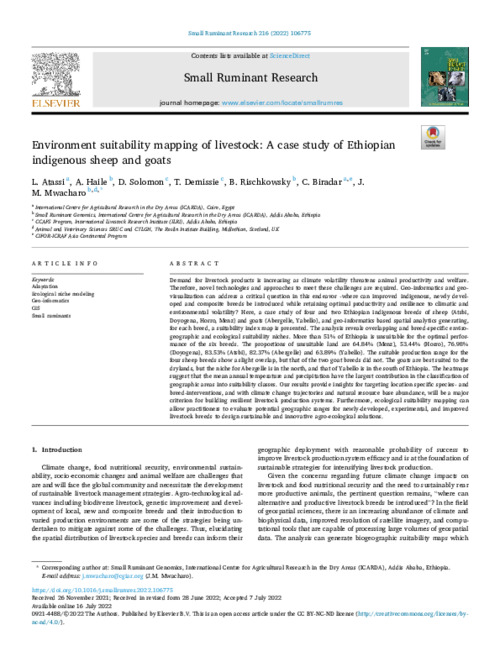Environment suitability mapping of livestock: A case study of Ethiopian indigenous sheep and goats
Abstract
Demand for livestock products is increasing as climate volatility threatens animal productivity and welfare. Therefore, novel technologies and approaches to meet these challenges are required. Geo-informatics and geo-visualization can address a critical question in this endeavor -where can improved indigenous, newly developed and composite breeds be introduced while retaining optimal productivity and resilience to climatic and environmental volatility? Here, a case study of four and two Ethiopian indigenous breeds of sheep (Atsbi, Doyogena, Horro, Menz) and goats (Abergelle, Yabello), and geo-informatics based spatial analytics generating, for each breed, a suitability index map is presented. The analysis reveals overlapping and breed-specific enviro-geographic and ecological suitability niches. More than 51% of Ethiopia is unsuitable for the optimal performance of the six breeds. The proportions of unsuitable land are 64.84% (Menz), 53.44% (Horro), 76.98% (Doyogena), 83.53% (Atsbi), 82.37% (Abergelle) and 63.89% (Yabello). The suitable production range for the four sheep breeds show a slight overlap, but that of the two goat breeds did not. The goats are best suited to the drylands, but the niche for Abergelle is in the north, and that of Yabello is in the south of Ethiopia. The heatmaps suggest that the mean annual temperature and precipitation have the largest contribution in the classification of geographic areas into suitability classes. Our results provide insights for targeting location specific species- and breed-interventions, and with climate change trajectories and natural resource base abundance, will be a major criterion for building resilient livestock production systems. Furthermore, ecological suitability mapping can allow practitioners to evaluate potential geographic ranges for newly-developed, experimental, and improved livestock breeds to design sustainable and innovative agro-ecological solutions

